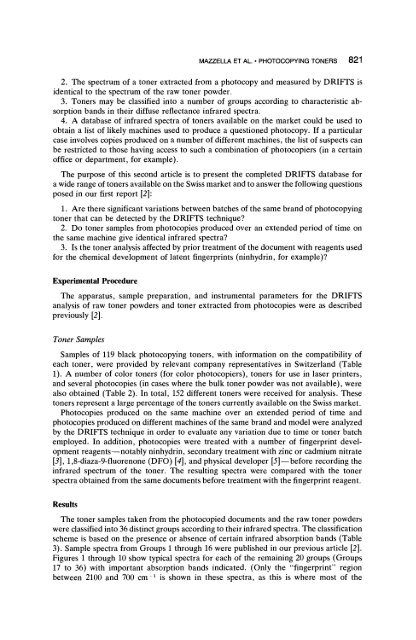Classification and Identification of Photocopying Toners by ... - Library
Classification and Identification of Photocopying Toners by ... - Library
Classification and Identification of Photocopying Toners by ... - Library
Create successful ePaper yourself
Turn your PDF publications into a flip-book with our unique Google optimized e-Paper software.
MAZZELLA ET AL. 9 PHOTOCOPYING TONERS 821<br />
2. The spectrum <strong>of</strong> a toner extracted from a photocopy <strong>and</strong> measured <strong>by</strong> DRIFTS is<br />
identical to the spectrum <strong>of</strong> the raw toner powder.<br />
3. <strong>Toners</strong> may be classified into a number <strong>of</strong> groups according to characteristic ab-<br />
sorption b<strong>and</strong>s in their diffuse reflectance infrared spectra.<br />
4. A database <strong>of</strong> infrared spectra <strong>of</strong> toners available on the market could be used to<br />
obtain a list <strong>of</strong> likely machines used to produce a questioned photocopy. If a particular<br />
case involves copies produced on a number <strong>of</strong> different machines, the list <strong>of</strong> suspects can<br />
be restricted to those having access to such a combination <strong>of</strong> photocopiers (in a certain<br />
<strong>of</strong>fice or department, for example).<br />
The purpose <strong>of</strong> this second article is to present the completed DRIFTS database for<br />
a wide range <strong>of</strong> toners available on the Swiss market <strong>and</strong> to answer the following questions<br />
posed in our first report [2]:<br />
1. Are there significant variations between batches <strong>of</strong> the same br<strong>and</strong> <strong>of</strong> photocopying<br />
toner that can be detected <strong>by</strong> the DRIFTS technique?<br />
2. Do toner samples from photocopies produced over an extended period <strong>of</strong> time on<br />
the same machine give identical infrared spectra?<br />
3. Is the toner analysis affected <strong>by</strong> prior treatment <strong>of</strong> the document with reagents used<br />
for the chemical development <strong>of</strong> latent fingerprints (ninhydrin, for example)?<br />
Experimental Procedure<br />
The apparatus, sample preparation, <strong>and</strong> instrumental parameters for the DRIFTS<br />
analysis <strong>of</strong> raw toner powders <strong>and</strong> toner extracted from photocopies were as described<br />
previously [2].<br />
Toner Samples<br />
Samples <strong>of</strong> 119 black photocopying toners, with information on the compatibility <strong>of</strong><br />
each toner, were provided <strong>by</strong> relevant company representatives in Switzerl<strong>and</strong> (Table<br />
1). A number <strong>of</strong> color toners (for color photocopiers), toners for use in laser printers,<br />
<strong>and</strong> several photocopies (in cases where the bulk toner powder was not available), were<br />
also obtained (Table 2). In total, 152 different toners were received for analysis. These<br />
toners represent a large percentage <strong>of</strong> the toners currently available on the Swiss market.<br />
Photocopies produced on the same machine over an extended period <strong>of</strong> time <strong>and</strong><br />
photocopies produced on different machines <strong>of</strong> the same br<strong>and</strong> <strong>and</strong> model were analyzed<br />
<strong>by</strong> the DRIFTS technique in order to evaluate any variation due to time or toner batch<br />
employed. In addition, photocopies were treated with a number <strong>of</strong> fingerprint devel-<br />
opment reagents--notably ninhydrin, secondary treatment with zinc or cadmium nitrate<br />
[3], 1,8-diaza-9-fluorenone (DFO) [4], <strong>and</strong> physical developer [5J--before recording the<br />
infrared spectrum <strong>of</strong> the toner. The resulting spectra were compared with the toner<br />
spectra obtained from the same documents before treatment with the fingerprint reagent.<br />
Results<br />
The toner samples taken from the photocopied documents <strong>and</strong> the raw toner powders<br />
were classified into 36 distinct groups according to their infrared spectra. The classification<br />
scheme is based on the presence or absence <strong>of</strong> certain infrared absorption b<strong>and</strong>s (Table<br />
3). Sample spectra from Groups 1 through 16 were published in our previous article [2].<br />
Figures 1 through 10 show typical spectra for each <strong>of</strong> the remaining 20 groups (Groups<br />
17 to 36) with important absorption b<strong>and</strong>s indicated. (Only the "fingerprint" region<br />
between 2100 <strong>and</strong> 700 cm-t is shown in these spectra, as this is where most <strong>of</strong> the

















